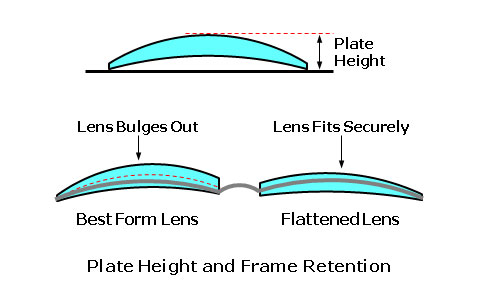The maximum thickness of a lens, for a given prescription, varies with the form of a lens. Flatter lens forms are slightly thinner than steeper lens forms, and vice versa. Since the lenses are thinner, they also have less mass—making them lighter in weight as well. In addition to lens thickness, varying the lens form will also produce significant differences in the plate height, or overall bulge, between lenses of the same power. Essentially, plate height is the height of a lens as measured from a flat plane.

Plus lenses with flatter plate heights do not fall out of frames as easily, which is especially important with large or exotic frame shapes. In addition, flatter plate heights are also more cosmetically pleasing than steeper, bulbous ones—particularly in plus powers.
A reduction in plate height will also provide a significant reduction in the magnification associated with plus lenses. Since a flatter plate height brings the back surface closer to the eye, the minification associated with minus lenses is also reduced slightly. This gives the wearer's eyes a more natural appearance through the lenses.
We can evaluate the maximum thickness, plate height, and weight for a range of lens forms to demonstrate the effects of lens form upon cosmesis for a given prescription. The table, below, represents a range of +4.00 D lenses in hard resin plastic, edged to a 70-mm diameter and a 1-mm minimum edge thickness.
|
+4.00 D Lenses
|
|||
|
Base Curve
|
Center
|
Plate
|
Weight
|
|
10.00 D Base
|
6.9 mm
|
15.3 mm
|
21.7 g
|
|
8.00 D Base
|
6.3 mm
|
11.7 mm
|
19.5 g
|
|
6.00 D Base
|
6.0 mm
|
8.7 mm
|
18.3 g
|
|
4.00 D Base
|
5.9 mm
|
6.0 mm
|
17.7 g
|
Note how the lenses become gradually thinner, flatter, and lighter in weight as the base curve is reduced—or flattened. The table, below, represents a range of -4.00 D lenses in hard resin, edged to a 70-mm diameter and a 2-mm minimum center thickness.
|
-4.00 D Lenses
|
|||
|
Base Curve
|
Edge
|
Plate
|
Weight
|
|
6.00 D Base
|
8.7 mm
|
16.4 mm
|
25.4 g
|
|
4.00 D Base
|
7.8 mm
|
12.8 mm
|
24.0 g
|
|
2.00 D Base
|
7.3 mm
|
9.7 mm
|
23.2 g
|
|
0.00 D Base
|
7.0 mm
|
7.0 mm
|
22.8 g
|
Again, the lenses become gradually thinner, flatter, and lighter in weight as the base curve is reduced. In summary, flatter lens forms provide the following mechanical and cosmetic benefits:
- Flatter (less "bulge")
- Thinner center thickness (plus) or edge thickness (minus)
- Lighter in weight
- Less magnification (or minification)
- Better frame retention (in plus powers)













